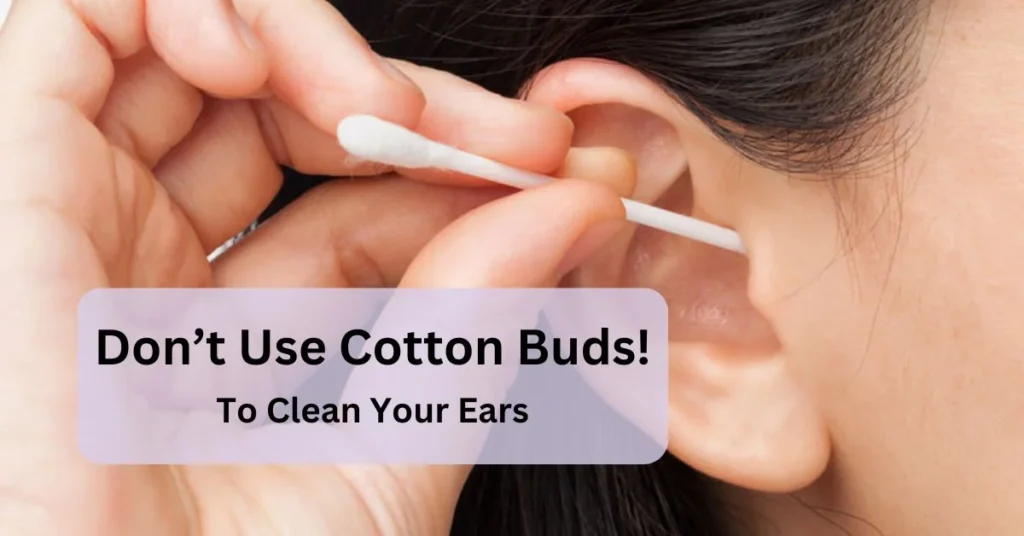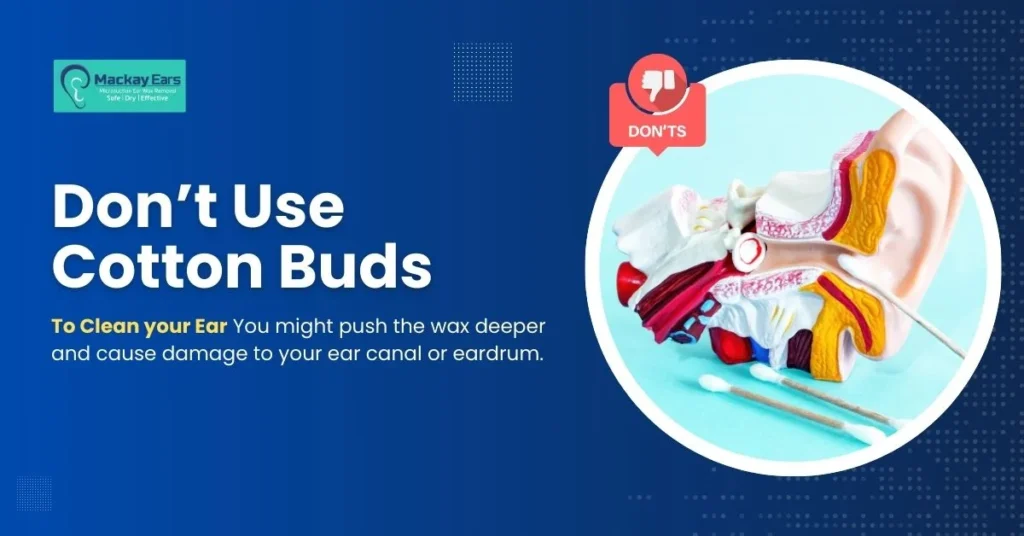Can You Use Cotton Buds to Clean Your Ears?
At Mackayears, we believe in promoting ear health and safety. While our ears serve essential functions like communication and enjoying music, it’s crucial to understand the risks associated with using cotton buds for ear cleaning. Let’s explore why cotton buds can be harmful and discuss alternative methods.
Many medical professionals encourage patients to avoid putting cotton buds, matchsticks, or safety pins into their ears. It is believed that the practice can cause impacted ear wax, a ruptured ear drum, or other painful conditions.
Why Cotton Buds Are Dangerous For Ear Cleaning

1. Risk of pushing earwax deeper into the ear canal
Cotton buds were invented in 1923 by Leo Gerstenzang to clean babies’ ears, eyes, and bellybuttons, they are now commonly used to remove earwax from the outer ear canal. Although manufacturers explicitly warn against the use of cotton buds in the ear, many people ignore this advice.
Putting objects into the ear canal pushes earwax deeper into the ear canal, eardrum, or the three tiny bones that help with hearing. This can lead to serious problems such as impacted earwax, infection or even perforating the eardrum and permanent hearing loss.
Earwax is a natural part of your ear health and it’s important that you leave it alone. If it builds up, see your ear cleaning specialist at Mackay Ears for help removing it safely and gently. You should also avoid using any other object in your ear canal as this can cause damage.
2. Potential for ear canal damage
The ear canal is designed to keep earwax away from the inner ear. When people stick cotton swabs or buds into their ears, they can push the wax deeper into the canal. This can lead to impacted earwax, which is uncomfortable and can cause hearing loss.
It’s also possible for cotton swabs to cause damage to the ear canal itself. This is sometimes called swimmer’s ear, or otitis externa. It can be painful and difficult to treat.
In some cases, the tip of a cotton swab can break off inside the ear and become stuck, causing pain and other problems. In severe cases, cotton swabs can damage or perforate the eardrum, which can lead to permanent hearing loss and other complications.

3. Increased chance of infections
Using cotton buds in the ears is not only unsanitary, but it can lead to serious health issues. The use of cotton buds is a leading cause of ear canal damage, impacted earwax, and ear infections.
Many people believe that they need to clean their ears with cotton swabs because they are itchy or have a buildup of wax. However, the ear is designed to self-clean itself. It has a natural ‘conveyor belt’ mechanism that moves earwax towards the ear opening, assisted by jaw movement from eating and talking, where it either falls out or gets washed away.
4. Possibility of perforating the eardrum
When you see earwax building up in your ears, your first instinct might be to raid the bathroom cupboard and grab a cotton bud to clean it out. However, this is not what cotton buds were designed for and it is incredibly dangerous for the ears.
Cotton swabs and buds can easily damage the outer ear canal and cause ear infections, irritation, and earwax impaction. They can also perforate the eardrum which is very painful and potentially leads to permanent hearing loss.
Ears are designed to self-clean
Many people use cotton buds even when their ears are not blocked. Often, people employ them to remove earwax or dry their ears after showering. This is a dangerous practice, as earwax is actually an important part of our body’s natural self-cleaning system. It protects the ear canal and helps to remove any debris that could cause irritation or infection. Using cotton buds to remove earwax strips the ear of this protective substance, leaving it dry and more susceptible to bacteria.
Even though cotton buds were never intended to be used as an ear cleaning tool and even the manufacturers explicitly warn against it, they continue to be one of the most common reasons for people to visit an ear, nose, and throat (ENT) clinic. Injuries caused by cotton bud use include eardrum perforation, otitis externa, impacted earwax, and ringing in the ear.
Earwax is sticky: They Strip Your Ear of Wax Which Can Be Protective
Didn’t your mum always tell you not to stick anything smaller than your elbow in your ears? That’s because sticking something into the ear canal, such as cotton swabs, hair pins, paper clips, or the end of a pencil, is not a good idea. It can cause a blockage of earwax or perforate the eardrum if done carelessly.
This is why doctors recommend letting your ears self-clean. The movement of your jaw as you chew and talk, and the shape of the ear canal help the earwax move from the ear canal to the ear opening, where it will either dry up or fall out naturally.
Earwax is sticky, and this enables it to trap dust and debris from the environment, as well as dead skin cells from the ear canal. It is a natural process and shouldn’t be interfered with. Aside from causing blockages, impacted earwax can lead to ear infections, which can then cause permanent hearing loss. The best at-home remedy is to use olive oil or ear wax softening drops, which can be bought at your local chemist and are safe for the ear canal and eardrum.
Earwax is natural
Earwax, or cerumen, is the body’s natural protectant for your ears. Your ear canal has glands and hairs that produce a waxy substance that lubricates the skin in your ear canal to prevent it from drying out or getting irritated. It also helps to filter out small particles of dirt and debris from entering your eardrum.
Avoid using cotton swabs or other implements to try to remove earwax, as this can push the earwax farther into your ear canal and damage the eardrum or ear canal. This is why you should only clean the external part of your ear with water or saline solution.
Conclusion:
The main problem with cotton swabs is that they can push wax deeper, which can cause blockages and even impact the eardrum. This can lead to earache, the feeling that the ear is full or a sense of ringing in the ear, and even a hole in the eardrum which can lead to serious health issues including tinnitus and long-term hearing loss.
This is why healthcare professionals do not recommend using cotton swabs or Q-tips to try and remove earwax. Instead, they recommend micro suction ear cleaning services that can safely remove excess earwax. This process involves gently inserting a small speculum into your ear canal to examine it and determine if the earwax needs softening or removal. The procedure is quick, comfortable and does not expose the ear to water which can lead to discomfort and irritation.
